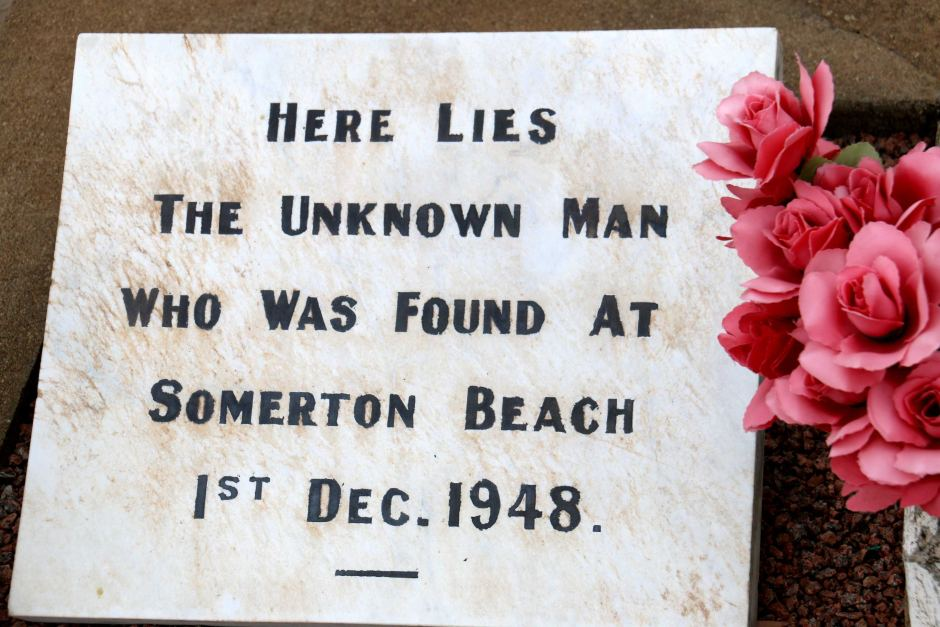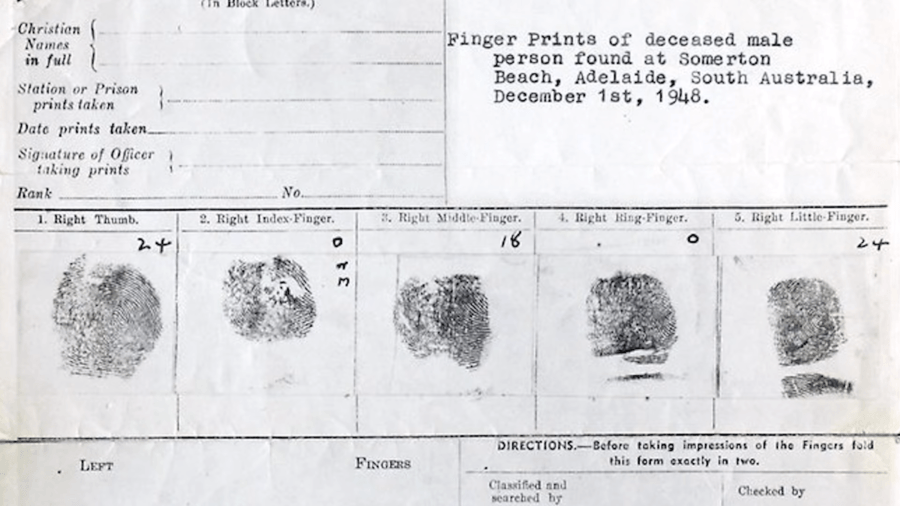An unknown dead body on an Adelaide Beach in post-war Australia.
In 1948 an unknown nameless man washed up on Somerton Park Beach in Adelaide, Australia. The man has never been identified and to this day, the country scratches its head. However; a trail of breadcrumbs has led to the discovery of the man’s possible descendants all the way down to the man’s (potential) great-grandkids living today in Australia.
On the 1st December 1948 at 6.30 am — the police were contacted after the body of a man was found in Somerton Park (about seven miles from the nearest major city Adelaide). The dead body of the man was found lying with his head resting against the seawall with legs extended and the feet crossed. The two boys that found him were out horse riding and initially thought that the man was sleeping or drunk. An unlit cigarette was on the right collar of his coat.
The Somerton Man
The man also had with him an unused train ticket from Adelaide to Henley Beach. He had in his possession an empty packet of Juicy Fruit, a comb manufactured in America, an Army Club (British cigarettes) cigarette packet, and a box of matches.
The pathologist said that the man had a “Britisher” appearance, was aged about 40–45, and was in extremely good physical condition;
“180 centimetres (5 ft 11 in) tall, with grey eyes, fair to ginger-coloured hair, slightly grey around the temples, with broad shoulders and a narrow waist, hands and nails that showed no signs of manual labour, big and little toes that met in a wedge shape, like those of a dancer or someone who wore boots with pointed toes; and pronounced high calf muscles consistent with people who regularly wore boots or shoes with high heels or performed ballet.”
The fantastic physique and intensity of calf muscles led some investigators to believe that the man must have been a ballet dancer of some sort or perhaps soccer?
The man was clean-shaven, wearing a double-breasted jacket and suit with “American” tailoring. The clothes that the Somerton Man wore had the labels removed. And his belongings, as well as the ethnic look of the man, suggested that he could have been Australian, European, or potentially American. South Australian police put out an urgent bulletin and many people came to view the body. And nobody local could identify the man.
The Somerton Man’s last meal was a pasty eaten four hours before death. There were no foreign agents in the man’s body, however, the suggestion was that the internal bleeding and over-enlarged spleen could indicate untraced poisoning. No trace of poison was found but there was intense strain found on some of his organs — including the heart.
The Somerton Man was embalmed, a death mask was created and he was promptly buried. The local residents generously paid for a headstone and funeral plot so that the man could be buried with a dignified memorial.

Months later the case’s most iconic clue was discovered. A tiny piece of rolled-up paper with the words Tamám Shud was discovered within the Somerton Man’s pockets. The words were not handwritten but instead were printed. A local library official and well-read local linked the pages to the last page of Rubaiyat of Omar Khayyam.
Rubaiyat of Omar Khayyam is a Persian book of poetry attributed to the Persian wordsmith Omar Khayyam and the words Tamám Shud were said to mean THE END (or ended).
The search for the book brought the police to a 1941 edition of the book (a Christchurch, New Zealand publication). The book indeed had the last page ripped out with the words Tamám Shud missing. On the last page, there was a faint indentation representing five lines of text, in capital letters — with possible encryption.

WRGOABABD
MLIAOI
WTBIMPANETP
x
MLIABOAIAQC
ITTMTSAMSTGAB
Even the Naval Intelligence could not crack this code. It remains unsolved as a riddle (or perhaps gibberish).
A phone number was written at the back of the book. This number led investigators to a local nurse who lived within Adelaide. When the nurse in question was shown the death mask, she was said to have been near hysteria at seeing the man and close to fainting and yet, she immediately denied knowing the deceased. She was evasive and refused to talk to investigators about the Somerton Man.
Police did not keep records of the witness nor her details and this hampered the investigation for the next 50 years. Her identity was not revealed at the time and the Australian Police force threw out her name and address (only keeping hold of the telephone number).
That is until over 50 years later Detective Gerry Feltus matched the telephone number written on the back of the book to a 1947 South Australian telephone directory (which the man had been trawling through every single day since picking up the cold case with the intention of linking the numbers).
This led police back to Jo Thomson — some 50 years after initial contact. Jo Thomson was continually evasive about the case, did not want to discuss the man, and did not let up about her connection to the found body, and to the day she died, she maintained her radio silence on the matter.
Jo Thomson had a son named Robin Thomson but unfortunately, Robin died before Feltus could interview him. Robin was a former ballet dancer with the same physical attributes as the Somerton Man including the distinguishable dancer’s calves that the mysterious Somerton Man had. Robin had the same genetic form of earlobes as the Somerton Man (lobe connected to the skin). This is a common connection in genetic ancestry, along with sharing their powerful calves and love of dance.
Professor Derek Abbottlater became engrossed in the case and would eventually locate Rachel Egan (Robin Thomson’s biological daughter and possibly the Somerton Man’s granddaughter).
The involvement of Mr. Abbott and Rachel Egan would soon turn romantic and they would end up marrying each other and having kids. Professor Abbott had become obsessed with solving the riddle and would draw to more scientific and forensic methods than those used in 1948–49.
Abbott consulted dental experts that concluded that the Somerton Man had hypodontia (a rare genetic disorder) and photographic evidence presented also showed that Robin Thomson had the same condition. Thus bringing the chance of a coincidence on this genetic connection as between one in 10,000,000 and one in 20,000,000. Abbott now fathers the possible great-grandchildren of the Somerton Man.
So Who Was The Somerton Man?
In establishing a potential genetic link all the way down to the man’s grandchildren, there is optimistic progress in this mystery. There is a direct link between the Somerton Man and the only found witness, the elusive Jo Thomson, and in 2021 DNA analysis was underway to find the definitive forensic links for the Somerton Man.
However; why was the man on the beach that day and what killed him?
This may never get an answer.
The most rampant theory is that the Somerton Man was a spy that knew too much. The death was unusual — there was no direct evidence of foul play but the lack of evidential poisoning could be an espionage trick (think of some of the recent types of spy-related murders from ricin to nerve agents). But why would a spy be lurking in the Australian suburbs? And why would an assassin be on his tail? The man clearly had a cosmopolitan aura — he couldn’t be identified, he carried American products, British products, Persian texts taken from a Kiwi library book. But beyond the spy out in the cold theory. It plays out perfectly against the Cold War era.
Or perhaps he was a drunk that fell asleep down on the beach…
There’s very little else to go on in terms of murder motives…
What do you think?

References;
On Dec. 1, 1948, beachgoers came across a dead man on Australia's Somerton beach. Well-dressed, and with no signs of…allthatsinteresting.com
Most murders aren't that difficult to solve. The husband did it. The wife did it. The boyfriend did it, or the…www.smithsonianmag.com

Comments
Post a Comment